PUF60 Promotes Chemoresistance Through Drug Efflux and Reducing Apoptosis in Gastric Cancer
- PMID: 39781520
- PMCID: PMC11704696
- DOI: 10.7150/ijms.102976
PUF60 Promotes Chemoresistance Through Drug Efflux and Reducing Apoptosis in Gastric Cancer
Abstract
Background: Chemotherapy resistance is a great challenge in the treatment of gastric cancer (GC), so it is urgent to explore the prognostic markers of chemoresistance. PUF60 (Poly (U)-binding splicing factor 60) is a nucleic acid-binding protein that has been shown to regulate transcription and link to tumorigenesis in various cancers. However, its biological role and function in chemotherapy resistance of GC is unclear. Methods: The expression and prognostic value of PUF60 in GC chemotherapy-resistant patients were analyzed by databases and K-M Plotter. The functional effect of PUF60 on chemoresistance in GC was studied by by RNA interference, CCK8 test, colony formation test and apoptosis detection. Moreover, further validation and mechanism exploration were conducted in clinical samples. Results: PUF60 was highly expressed in both GC and chemoresistant tissues, and was positively correlated with poor prognosis in GC patients treated with 5-fluorouracil (5-FU). In addition, the knockdown of PUF60 significantly reduced the proliferation of human gastric cancer cells and increased sensitivity to chemotherapy drugs, such as 5-FU and cisplatin (CDDP). Mechanistically, PUF60 enhances chemotherapy resistance in gastric cancer (GC) cells by actively excluding chemotherapy drugs via the recombinant ATP Binding Cassette Transporter A1 (ABCA1) and ATP Binding Cassette Subfamily C Member 1 (ABCC1). This process further affects the cell cycle, reduces cell apoptosis, and ultimately promotes resistance to chemotherapy in GC. Conclusion: PUF60 promotes chemoresistance in GC, resulting in poor prognosis of GC patients treated with 5-FU, and providing a new idea for overcoming the chemoresistance in GC.
Keywords: Chemoresistance; Gastric cancer; PUF60; Prognostic biomarkers.
© The author(s).
Conflict of interest statement
Competing Interests: The author(s) declared no potential conflicts of interest with respect to the research, authorship, and/or publication of this article.
Figures
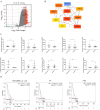
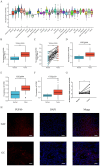
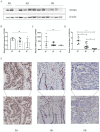
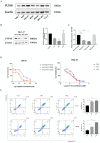
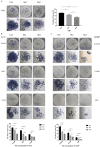

Similar articles
-
Macrophages enhance cisplatin resistance in gastric cancer through the transfer of circTEX2.J Cell Mol Med. 2024 Mar;28(5):e18070. doi: 10.1111/jcmm.18070. Epub 2023 Dec 15. J Cell Mol Med. 2024. PMID: 38102848 Free PMC article.
-
Identification and validation of the role of ZNF281 in 5-fluorouracil chemotherapy of gastric cancer.J Cancer Res Clin Oncol. 2024 Jun 16;150(6):307. doi: 10.1007/s00432-024-05838-8. J Cancer Res Clin Oncol. 2024. PMID: 38880820 Free PMC article.
-
Upregulation of miR-34c after silencing E2F transcription factor 1 inhibits paclitaxel combined with cisplatin resistance in gastric cancer cells.World J Gastroenterol. 2020 Feb 7;26(5):499-513. doi: 10.3748/wjg.v26.i5.499. World J Gastroenterol. 2020. PMID: 32089626 Free PMC article.
-
Mechanism of cisplatin resistance in gastric cancer and associated microRNAs.Cancer Chemother Pharmacol. 2023 Nov;92(5):329-340. doi: 10.1007/s00280-023-04572-1. Epub 2023 Aug 3. Cancer Chemother Pharmacol. 2023. PMID: 37535106 Review.
-
Portrayal of the complex molecular landscape of multidrug resistance in gastric cancer: Unveiling the potential targets.Exp Cell Res. 2025 Jun 1;449(1):114580. doi: 10.1016/j.yexcr.2025.114580. Epub 2025 Apr 29. Exp Cell Res. 2025. PMID: 40306607 Review.
Cited by
-
A pan-cancer analysis targeting the oncogenic role of ATP-binding cassette transporter A1 in human tumors.Front Oncol. 2025 Apr 14;15:1513992. doi: 10.3389/fonc.2025.1513992. eCollection 2025. Front Oncol. 2025. PMID: 40297807 Free PMC article. Review.
References
-
- Smyth EC, Nilsson M, Grabsch HI, van Grieken NC, Lordick F. Gastric cancer. Lancet. 2020;396:635–48. - PubMed
-
- Ferlay J, Colombet M, Soerjomataram I, Mathers C, Parkin DM, Piñeros M. et al. Estimating the global cancer incidence and mortality in 2018: GLOBOCAN sources and methods. Int J Cancer. 2019;144:1941–53. - PubMed
-
- Wang Q, Xiong J, Qiu D, Zhao X, Yan D, Xu W. et al. Inhibition of PARP1 activity enhances chemotherapeutic efficiency in cisplatin-resistant gastric cancer cells. Int J Biochem Cell Biol. 2017;92:164–72. - PubMed
-
- Mahipal A, Malafa M. Importins and exportins as therapeutic targets in cancer. Pharmacol Ther. 2016;164:135–43. - PubMed
MeSH terms
Substances
LinkOut - more resources
Full Text Sources
Medical
Miscellaneous

